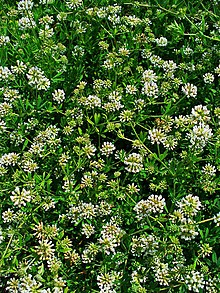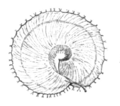Loteae
| Loteae | ||||||||||||
|---|---|---|---|---|---|---|---|---|---|---|---|---|

Left: vaginal vetch ( Coronilla vaginalis ) and right: colorful vetch ( Securigera varia ), illustration. |
||||||||||||
| Systematics | ||||||||||||
|
||||||||||||
| Scientific name | ||||||||||||
| Loteae | ||||||||||||
| DC. |
Loteae is a tribe in the subfamily of the butterflies (Faboideae) within the family of legumes (Fabaceae). The species mostly thrive in temperate areas.
description

Appearance and leaves
There are year to perennial herbaceous plants , which often become woody something, or there are half bushes to bushes .
The alternate and mostly two-line leaves are stalked. The unpaired or finger-shaped pinnate leaf blades usually have three or five to many, rarely only one or two leaflets. The leaflets are always entire. The leaf blades are rarely simple and can then be lobed. The stipules are free or fused with the base of the petioles and often have glands that are reduced to glands.
Inflorescences and flowers
The flowers are usually laterally over more or less long Blütenstandsschäften in doldigen or capitate part inflorescences that are rarely reduced to solitary flowers. Herbaceous bracts may be present. The bracts are usually small and inconspicuous and are typically (if this is the case with the stipules) converted to glands or may be missing. Cover sheets are usually missing.
The hermaphrodite flowers are zygomorphic and five-fold with a double flower envelope . The five sepals are fused bell-shaped or tubular. The five petals stand together in the shape typical of butterflies . The flag narrows towards the bottom or is nailed and can have thickened inwardly folded edges. Of the ten stamens , nine have grown together like tubes, one is free or is connected to the others to form a closed tube during development. The stamens widen upwards. The dust bags are all the same. The single carpel is on top. The style is smooth or papilose , usually bald along its entire length, but sometimes hairy around the scar tissue.
Fruits and seeds
The legumes open at maturity zweiklappig or remain closed or broken in closed constant or opening parts. The seeds have a smooth surface.
- legumes
Systematics


The Tribus Loteae was established in 1825 by Augustin Pyrame de Candolle in Prodromus Systematis Naturalis Regni Vegetabilis , 2, p. 214. A synonym for Loteae DC. is Coronilleae Adans. The earlier tribe Coronilleae was incorporated into the tribe Loteae s. l. incorporated.
Per Lassen worked on the sub- tribus Coronillinae in 1989 , rearranging and delimiting the genera Coronilla , Hippocrepis and Securigera . For example, the crown vetch Coronilla emerus L. was placed in the genus Hippocrepis as Hippocrepis emerus (L.) Lassen .
There are 16 to 18 genera with about 270 species in the tribe Loteae:
- Wundklee ( Anthyllis L. , Syn .: Acanthyllis Pomel , Aspalathoides (DC.) K. Koch , Cornicina Boiss. ): The approximately 24 to 30 species are distributed in Europe, North Africa and the Middle East.
-
Antopetitia A. Rich . : It contains only one type:
- Antopetitia abyssinica A.Rich. : It occurs in Africa.
- Crown vetch ( Coronilla L. ) (Syn .: Artrolobium Desv. , Bonaveria Scop. ): The nine or so species are distributed in Europe, Western Asia and northeastern Africa.
- Cytisopsis Jaub. & Spach (Syn .: Lyauteya Maire ): It contains about two types:
- Cheeky clover ( Dorycnium Mill. ): The ten or so species occur from the Mediterranean to the Canary Islands.
-
Dorycnopsis Boiss. : It contains about two types:
- Dorycnopsis abyssinica (A.Rich.) VNTikhom. & DDSokoloff:: It occurs in Ethiopia, northern Somalia and Sudan.
- Dorycnopsis gerardi (L.) Boiss. (Syn .: Anthyllis gerardi L. ): Your home is Morocco, the Iberian Peninsula , France, Corsica, Sardinia and Italy.
-
Hammatolobium Fenzl : It only includes two types:
- Hammatolobium kremerianum (Coss.) C. Mueller : It occurs in Morocco and Algeria.
- Hammatolobium lotoides Fenzl : It occurs in Greece, North Africa and the Asian part of Turkey.
- Hippocrepis L. (Syn .: Emerus Mill. ): The 32 or so species arewidespreadin Europe, the Mediterranean, the Canary Islands, the Cape Verde Islands , the Arab region and Pakistan .
-
Hymenocarpos Savi (Syn .: Circinnus Medik. ): It contains only one species:
- Penny clover ( Hymenocarpos circinnata (L.) Savi ): It is widespread in the Mediterranean region.
-
Kebirita Sokoloff : It contains only one type:
- Kebirita roudairei (Bonnet) Kramina & DDSokoloff : It thrives in the Sahara .
- Hornklee ( Lotus L. , Syn .: Acmispon Raf. , Anisolotus Bernh. Ex Schltdl. , Benedictella Maire , Heinekenia Webb ex H.Christ , Hosackia Benth. Ex Lindl. , Ottleya Sokoloff , Kerstania Rech. F. , Pseudolotus Rech. F . , Syrmatium Vogel , Tetragonolobus Scop. ): There are about 125 species.
- Ornithopus L .: There are about six species in Eurasia and North Africa.
-
Podolotus Royle : it contains only one species:
- Podolotus hosackioides Benth. : It occurs in India , Pakistan , Afghanistan and Iran .
- Scorpion tail ( Scorpiurus L. ): The approximately three species are common in Eurasia, North Africa and Australia.
- Beilwicken ( Securigera DC. ): There are about 12 to 13 species in Eurasia and North Africa.
-
Tripodion medic. (Syn .: Physanthyllis Boiss. ): It contains only one species:
- Bladder clover ( Tripodion tetraphyllum (L.) Fourr. ): It is common in the Mediterranean region.
swell
- Wu Zheng-yi, Peter H. Raven, Deyuan Hong (Eds.): Flora of China. Volume 10: Fabaceae. Science Press and Missouri Botanical Garden Press, Beijing and St. Louis 2010, ISBN 978-1-930723-91-7 . Zhi Wei, Tatiana E. Kramina, Dmitry D. Sokoloff: Loteae , pp. 316–319 - the same text online as the printed work. (Sections Description and Systematics)
- GJ Allan, J. Mark Porter: Tribal delimitation and phylogenetic relationships of Loteae and Coronilleae (Faboideae: Fabaceae) with special reference to Lotus: evidence from nuclear ribosomal ITS sequences. In: American Journal of Botany , Volume 87, No. 12, 2000, pp. 1871-1881: full text in HTML format.
Individual evidence
- ↑ First publication scanned at biodiversitylibrary.org .
- ↑ [ Loteae at Tropicos.org. Missouri Botanical Garden, St. Louis
- ↑ a b Loteae in the Germplasm Resources Information Network (GRIN), USDA , ARS , National Genetic Resources Program. National Germplasm Resources Laboratory, Beltsville, Maryland.
- ↑ Per Lassen: A new delimitation of the genera Coronilla, Hippocrepis and Securigera (Fabaceae). In: Willdenowia , Volume 19, Berlin 1989, pp. 49-62, JSTOR 3996918 .
- ↑ Enter the generic name in the search mask at ILDIS = International Legume Database & Information Service .
further reading
- Zaki Turki1, Faiza Shehata, Esam Aqlanorcid: Taxonomic Studies in Tribe Loteae (Fabaceae) in Egypt. I: Subtribe Anthyllidinae (Anthyllis, Hymenocarpos and Tripodion). In: Egyptian Journal of Botany , Volume 59, Issue 2, 2019, pp. 523-536. doi : 10.21608 / ejbo.2019.5705.1234 PDF 1.23 MB .
- Dmitry D. Sokoloff, Galina V. Degtjareva, Peter K. Endress, Margarita V. Remizowa, Tahir H. Samigullin, Carmen M. Valiejo-Roman: Inflorescence and Early Flower Development in Loteae (Leguminosae) in a Phylogenetic and Taxonomic Context. In: International Journal of Plant Sciences , Volume 168, Number 6, 2007, pp. 801-833. doi : 10.1086 / 518272
- GP Lewis, B. Schrire, B. MacKinder, M. Lock (Eds.): Legumes of the World. XIV, Royal Botanic Gardens, Kew, ISBN 1-900347-80-6 . Loteae online.
- GJ Allan, Elizabeth Anne Zimmer, Warren L. Wagner, DD Sokoloff: Molecular Phylogenetic Analysis of Tribe Loteae (Fabaceae); Implications for Classification and Biogeography. In: B. Klitgaard, A. Bruneau: Advances in legume systematics, part 10, higher level systematic , 2003, pp. 371-393. ( PDF ; 634 kB)
- Galina V. Degtjareva, Carmen M. Valiejo ‐ Roman, Tatiana E. Kramina, EM Mironov, TH Samigullin, Dmitry D. Sokoloff: Taxonomic and phylogenetic relationships between Old World and New World members of the tribe Loteae (Leguminosae): new insights from molecular and morphological data, with special emphasis on Ornithopus. In: Wulfenia , Volume 10, 2003, pp. 15−50.






